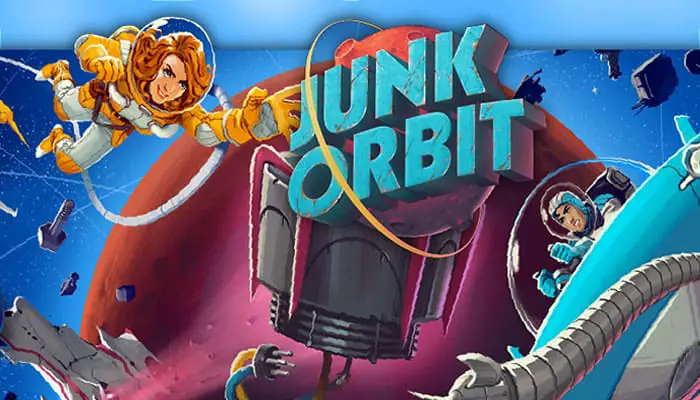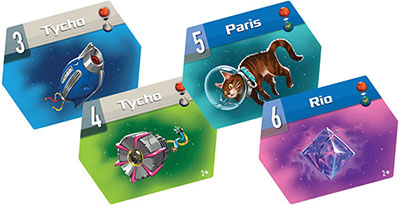
One planet's junk is another planet's treasure! You captain your own scavenger ship, collecting space junk and transporting it to any city that will take it. Launching cargo out the airlock lets you make remote deliveries and propel your ship the same distance, but in the opposite direction, to make direct deliveries - it's astrodynamics for fun and profit!
Components
- 5 Location Boards
- 15 Starter tiles
- 37 Source: Earth Tiles
- 29 Source: Moon Tiles
- 47 Source: Mars Tiles
- 5 Ship Tokens
- 5 Ship Cards
The Junk Tiles

Value: The number indicates the junk's relative mass - and therefore its value in victory points (VP) at the end of the game if the junk has been delivered.
Source: The source of a junk tile is indicated by a color-coding system:
-
 Source EARTH: junk tiles have a blue back
Source EARTH: junk tiles have a blue back -
 Source MOON: junk tiles have a gray back
Source MOON: junk tiles have a gray back -
 Source: MARS: junk tiles have a red back
Source: MARS: junk tiles have a red back -
 The STARTER junk tiles have a black back
The STARTER junk tiles have a black back
Destination: The name along the top of the junk tile indicates to which city the junk tile must be delivered. The city name's background is color-coded to help you find its location:
- Earth destinations are on blue
- Moon destinations are on gray
- Mars (including Phobos and Deimos) destinations are on red.
The starter junk tiles have no destination.
Player Count: This indicates at which player counts this tile will be included in the game.
The Location Boards

Art: Each board depicts a celestial body: Earth, the Moon, Mars, Phobos, or Deimos.
Cities: Each named section around the outer edge of a board represents a city. Earth and Mars have 9 cities each, the Moon has 5 cities, Phobos has 3 cities, and Deimos has 2 cities. The Moon, Phobos, and Deimos boards have edges with specific icons that match up with icons on the Earth and/or Mars boards, indicating how to properly align them.
Day or Night side: Each board has a Day side (basic game) and a Night side (advanced game).
The Ship Cards

Color and Icon: Each ship card corresponds to 1 of the 5 ship tokens.
Name: The name of your ship and a brief description.
Reference: A summary of the steps you will perform on your turn.
Cargo: This area is where you keep junk tiles that you are currently hauling on your ship. Deliveries: This area is where you keep junk tiles that you have successfully delivered.
Special Power: Your ship has a special power. Each ship card has an "A" side (basic game) and a "B" side (advanced game) with different powers.
Setup
Example 5-player Setup

-
Align the location boards.
For the basic game, place these with their Day sides up.
- 2+ Players: Use the Earth, Moon, and Mars boards. Arrange them so that Earth and the Moon align at Kilimanjaro (marked by stars) and Mars and the Moon align at Olympus (marked by asterisks).
- 4+ Players: Add the square Phobos board, aligning it with the Mars board at Bradbury (marked by a square) as shown.
- 5 Players: Add the triangular Deimos board, aligning it with the Mars board at Hellas (marked by a triangle) as shown.
-
Prepare the junk tiles.
Shuffle separate stacks of Earth junk tiles, Moon junk tiles, and Mars junk tiles, using the steps below to build each stack. After shuffling, place each stack near its corresponding board.
- 2 or 3 Players: Use only the junk tiles marked as 2+.
- 4 Players: Use only the junk tiles marked as 2+ and 4+.
- 5 Players: Use all of the junk tiles, including those marked as 5+.
-
Seed the cities
Place 1 random Earth junk tile at each Earth city, 1 random Moon junk tile at each Moon city, and 1 random Mars junk tile at each Mars city (including the cities of Phobos and Deimos, if they're in play). Do NOT double up on the spaces that are between 2 orbits (e.g., Kilimanjaro gets an Earth junk tile, but not a Moon junk tile).
-
Give each player a ship.
Each player should receive a random ship card and place it "A" side up in front of them. Each player should also take the matching ship token and place it on Kepler (on the Moon).
-
Set up each player's starting cargo.
Place two "1" starter junk tiles and one "2" starter junk tile face up in each player's CARGO area, then return any unused starter junk tiles to the box.
Each player also takes 1 random junk tile from the top of each stack. In total, each player begins the game with 6 junk tiles in their cargo: 3 starters, 1 from Earth, 1 from the Moon, 1 from Mars.
Game Play
Players take turns in clockwise order, beginning with the player who most recently took out the garbage. (If no one has, race to the nearest bin and do that). Turns will continue, 1 at a time, until the end of the game has been triggered.
On your turn, you will follow these 3 steps:
- Launch junk
- Move ship
- Pick up junk
I. Launch Junk
Choose a junk tile in your cargo area. Move it away from your ship token clockwise or counterclockwise (your choice) around your current location board.

It must travel a number of cities equal to the junk tile's value. It will then stop, and either come to rest or make a remote delivery. In addition, the junk tile could also hit an opponent's ship where it stops.
Rest: If your launched junk tile stops at a city that is not its destination city, then the junk tile will stay there. Any number of junk tiles can be at a city.
Remote Delivery: If your launched junk tile stops at its destination city, then you have just made a remote delivery! Place the junk tile face down in your deliveries area. (Note: Starter junk tiles have no destination, so they cannot be delivered).
Hit: If your junk tile stops at a city occupied by an opponent's ship, their ship is hit. That opponent must choose a junk tile from their cargo or deliveries area and place it at their ship's current city. If there are multiple opponents' ships at the city, then each is hit.
II. Move Ship

Note the value on the junk tile you just launched. You must now move your ship that exact number of cities, but in the opposite direction of your launched junk tile.
While moving, you may pass through or occupy the same city as opponents' ships. After your move is complete, you may make a direct delivery, if possible.
Direct Delivery: If your ship stops at the destination city of any junk tiles in your cargo, then you can deliver that junk! You may deliver as many of those junk tiles as you wish. Place any delivered junk tiles face down in your deliveries area.
III. Pick Up Junk
After moving your ship, take all of the junk tiles present at your ship's current city and add them to your ship's CARGO. (There is no maximum cargo limit). Then refill your current city.
Refill: Add 1 junk tile to the now empty city, from the top of the corresponding junk stack. An Earth city is always refilled with an Earth junk tile, a Moon city with a Moon junk tile, and a Mars city is always refilled with a Mars junk tile.
Note: Kilimanjaro is an Earth city and Olympus is a Mars city.
Switching Orbits
Certain cities are transfer points where your launched junk or moving ship may switch orbits between location boards.
Kilimanjaro is a transfer point between Earth and the Moon.
Olympus is a transfer point between the Moon and Mars.
Bradbury is a transfer point between Mars and Phobos.
Hellas is a transfer point between Mars and Deimos.
Switching orbits is always optional. When switching orbits, your junk or ship must maintain the same direction of travel - this means if it was traveling clockwise, it'll travel counter-clockwise after switching orbits, and vice versa. (Imagine the slingshot effect caused by gravity).

Example Launch: You control the yellow ship at Kepler. You launch a "4". Here are the possible launch outcomes.
aIt may switch orbits to land on Tharsis. Because Tharsis is the junk's destination, you remotely deliver this junk! Place this junk tile in your DELIVERIES.
bIt may rest on Copernicus. It hits the purple ship. The purple player must then discard a junk tile of their choice from their CARGO or DELIVERIES onto Copernicus.
cIt may rest on Hamilton.
dIt may switch orbits at Kilimanjaro and rest on NYC.

Example Move: You chose the first option in the previous example, delivering that tile to Tharsis. Your ship must move 4 cities in the opposite direction. Here are the possible outcomes.
aYour ship may land on NYC. You then pick up all the tiles from NYC and place them in your CARGO. Then refill NYC with an Earth tile.
bYou may land on Hamilton. You have 2 junk tiles in your CARGO with that destination. You directly deliver them! Place them in your DELIVERIES. You then pick up all the tiles from Hamilton and place them in your CARGO. Then refill Hamilton with a Moon tile.
End of the Game
The end of the game is triggered when a city must be refilled but its stack is empty. When this happens, each other player takes 1 final turn, then the game ends.
Final Score: Add together the point values of all junk tiles in your DELIVERIES area; this is your final score. The player with the highest score wins! If tied, the tied player who delivered more junk tiles wins! If still tied, race to the nearest bin and take out the garbage again.
Continue Reading
